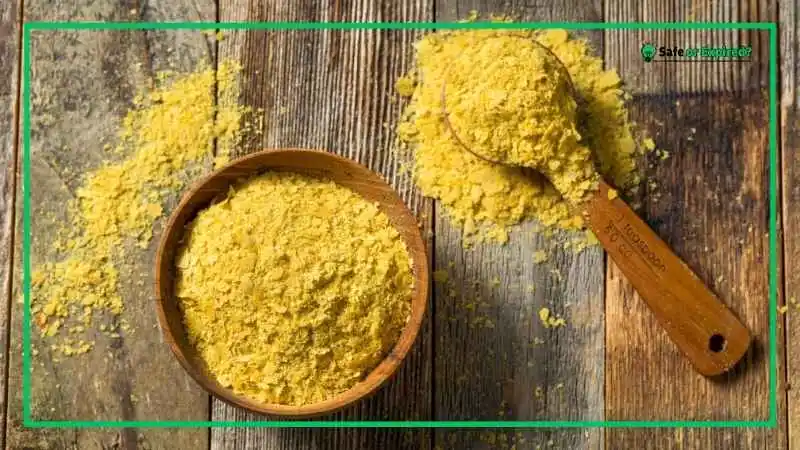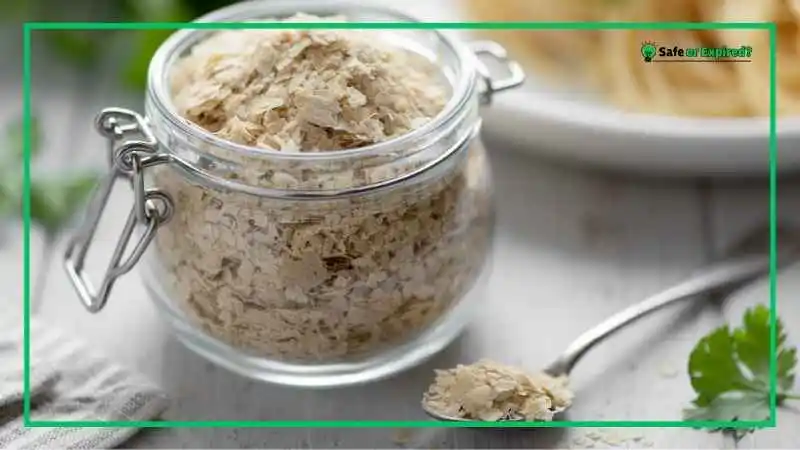“Does nutritional yeast go bad?” is a common concern for people managing their pantry inventory. Yes, nutritional yeast can go bad if not stored properly.
Let’s dive into how to keep it fresh, what to watch out for, and why proper storage matters. By the end of this guide, you’ll be a pro at managing your nutritional yeast stash!
Does nutritional yeast go bad?
Nutritional yeast can go bad if not stored properly. Over time, it may lose its flavor, potency, and nutritional value. Proper storage practices can extend the yeast’s shelf life, but exposure to air, moisture, and heat can cause it to spoil more quickly.
It’s essential to keep nutritional yeast in a dry place to maintain its quality.
So, how long does nutritional yeast last? Unopened, it can last anywhere from 6 months to 2 years. Once opened, its shelf life typically ranges from 1 to 2 years if kept in an airtight container in a cool, dry place.
How Long Does Nutritional Yeast Last Once Opened?

Once opened, nutritional yeast should be stored in an airtight container to maintain its freshness. It generally lasts for 1 to 2 years when stored in a dry place. Refrigerating nutritional yeast can extend this period to 2+ years, ensuring it remains potent and flavorful.
Does Nutritional Yeast Go Bad If Unopened?
Unopened nutritional yeast generally has a long shelf life, typically lasting between 6 to 24 months. However, it’s crucial to check the expiration date on the package. If stored in a dry place, unopened nutritional yeast can retain its quality and nutritional benefits for a more extended period without going bad.
Does Nutritional Yeast Go Bad in the Fridge?
Storing nutritional yeast in the fridge can help prolong its shelf life. The cold environment slows down the degradation process, keeping it fresh for up to 2 years or more. Moreover, ensure the container is airtight.
Here’s the shelf life table of nutritional yeast:
| Counter | Fridge | Freezer | |
| Unopened | 6-24 months | 24 months | 2+ years |
| Unopened | 12-24 months | 2 years | 2+ years |
| Opened | Two years | 2+ years | 2+ years |
| Opened | 1-2 years | 2+ years | 2+ years |
If you’re curious about how long nutritional yeast lasts, you might also be wondering about regular yeast. Read this detailed discussion on whether you can use expired yeast and uncover the secrets of its shelf life.
4 Signs That Nutritional Yeast Has Gone Bad
Nutritional yeast can go bad if not stored properly. Look for signs like a change in color, an off smell, a different taste, or the presence of moisture or mold. If you notice any of these, it’s best to throw it out and get a new batch.
Change in Color
When nutritional yeast goes bad, its color might change. Fresh nutritional yeast usually has a bright yellow or golden color. If it turns darker or looks brownish, it’s a sign that it’s no longer good. Always check the color before using it. This is a picture of spoiled nutritional yeast:

If you notice a color change, it’s better to be safe and not use it. Keeping an eye on the color helps ensure you’re only using fresh, nutritious yeast in your food.
Off Smell
Another clear sign that nutritional yeast has gone bad is a strange smell. Fresh nutritional yeast has a nutty or cheesy aroma. If it starts to smell bad, it’s likely spoiled. A bad smell means it’s time to toss it out.
Your nose knows best, so trust it! Sniff your nutritional yeast before adding it to your recipes. If it doesn’t smell right, it’s best to get a fresh batch.
Different Taste
Taste is another way to tell if your nutritional yeast is still good. Fresh nutritional yeast has a delicious, savory flavor. If it tastes bitter, sour, or just not right, it has probably gone bad. Always taste a tiny bit before using it in your dishes.
If it doesn’t taste as expected, don’t use it. Using fresh nutritional yeast ensures your meals are both tasty and healthy.
Presence of Moisture or Mold
Moisture or mold is a sure sign that nutritional yeast is spoiled. Nutritional yeast should always be dry. If you see any clumps, moisture, or mold spots, it’s time to throw them away. Moisture can cause it to spoil quickly, and mold can make it unsafe to eat.
Keep your nutritional yeast in a dry place to avoid this problem. Checking for moisture or mold helps keep your food safe and yummy.
What happens if you eat expired nutritional yeast?
Eating expired nutritional yeast may not be harmful, but it could lose potency and flavor. Typically, it won’t make you sick unless it shows signs of spoilage, like a bad smell or visible mold. Always check for these indicators before consuming expired products.
In some cases, it can cause mild digestive issues if it’s spoiled.
Mild Digestive Issues
If you eat expired nutritional yeast, you might experience mild digestive issues. This can include stomach aches, gas, or bloating. These symptoms happen because spoiled yeast can upset your stomach.
Always check the printed expiration date and look for spoilage before using nutritional yeast. If you’re unsure, it’s better to throw it out and get a fresh batch. Keeping your digestive system happy is worth a little extra caution.
Bad Taste
Expired nutritional yeast often tastes bad. It can become bitter, sour, or just plain off. This change in taste happens because the yeast breaks down over time. Using bad-tasting yeast can ruin your recipes, making your meals less enjoyable.
Always taste a small amount before adding it to your dishes. If it doesn’t taste right, don’t use it. Enjoying delicious food means using fresh, tasty ingredients every time.
Loss of Nutritional Value
One downside of eating expired nutritional yeast is the loss of nutritional value. Over time, the vitamins and minerals in nutritional yeast degrade. This means you won’t get the same health benefits from expired yeast as you would from fresh yeast.
To keep getting those great nutrients, like B vitamins and protein, make sure your nutritional yeast is within its shelf life. Using fresh yeast helps you stay healthy and get the most out of your food.
Possible Allergic Reactions
People also ask, “Can nutritional yeast make you sick?” Well, in rare cases, eating expired nutritional yeast can cause allergic reactions. If you have a yeast allergy or sensitivity, spoiled yeast might trigger symptoms like itching, rash, or swelling.
Always check your nutritional yeast for signs of spoilage, and avoid using it if it’s past its expiration date.
Does nutritional yeast need to be cooked?
Nutritional yeast does not need to be cooked. You can sprinkle it directly for a cheesy, nutty flavor. It’s great on popcorn, pasta, and salads. However, cooking it can enhance the taste of some dishes.
This way, it stays fresh and ready to use whenever you need it.
Whether you use it raw or cooked, always check for spoilage to ensure the best flavor and nutrition.
How to Store Nutritional Yeast Properly? 10 Reliable Tips
To store nutritional yeast properly, keep it in a cool, dry pantry. Avoid exposure to moisture, heat, and direct sunlight. Proper storage helps maintain its flavor, texture, and nutritional value for a longer time.
Use an Airtight Container
Using an airtight container is crucial for keeping nutritional yeast fresh. When you store it in an airtight container, you protect it from air and moisture, which can cause it to spoil faster.
I recommend a glass jar with a tight-sealing lid or a high-quality plastic container. This way, your nutritional yeast stays dry and free from contaminants, ensuring it remains tasty and nutritious.
Keep It Cool
Store your nutritional yeast in a cool place to extend its shelf life. Heat can make it spoil faster, so avoid keeping it near the stove, oven, or any other heat source.
By keeping it cool, you ensure that it maintains its flavor and nutritional benefits longer. Remember, the cooler the storage area, the longer your nutritional yeast will stay fresh.
Avoid Direct Sunlight
Direct sunlight can degrade the quality of nutritional yeast. Always store it in a dark place to keep it fresh. Sunlight can cause the yeast to lose its color and nutrients.
I suggest placing it in a cabinet or pantry where sunlight can’t reach it. Keeping it away from sunlight helps maintain its bright color, delicious taste, and health benefits.
Store in Small Batches
Storing nutritional yeast in small batches can help keep it fresh. Instead of keeping a large container that you open frequently, divide it into smaller portions. This way, you only expose a small amount of air each time you use it.
Smaller containers are easier to manage and ensure the rest of your yeast stays fresh and uncontaminated. This tip helps you enjoy fresh nutritional yeast every time.
Use a Desiccant Packet
Adding a desiccant packet to your nutritional yeast container can absorb moisture and keep it dry. These packets are safe and help prevent clumping and spoilage. You can find desiccant packets online or reuse ones from other food products.
Place the packet on top of the yeast in the container. It’s an easy and effective way to extend the shelf life of your nutritional yeast.
Refrigerate for Longer Shelf Life
Refrigerating nutritional yeast can help it last even longer. Make sure to keep it in an airtight container to prevent moisture from getting in.
Refrigeration is especially useful if you live in a hot, humid climate. This method ensures your nutritional yeast stays fresh and ready to use for months.
Freeze for Maximum Freshness
For maximum freshness, you can freeze nutritional yeast. Freezing keeps it fresh for an extended period.
When you need some, just take out the amount you need and return the rest to the freezer. This method keeps your nutritional yeast fresh and full of nutrients for a long time.
Label with Date
Always label your nutritional yeast container with the date you opened it. This helps you keep track of how long you’ve had it. Knowing the date ensures you use it within its optimal shelf life. I recommend using a permanent marker on a piece of tape or a label.
This simple step helps you manage your pantry better and avoid using expired yeast.
Avoid Contamination
Preventing contamination is key to keeping nutritional yeast fresh. Always use a clean, dry spoon. Don’t let moisture or other food particles get into the container. This prevents mold and bacteria from growing.
Keeping your yeast uncontaminated ensures it stays safe to eat and retains its flavor and nutrients.
Keep Away from Strong Odors
Nutritional yeast can absorb strong odors from other foods. Store it away from items with strong smells, like spices or onions. This helps keep its flavor pure and delicious.
I recommend keeping it in a dedicated area of your pantry or kitchen cabinet. Keeping it away from strong odors ensures that your nutritional yeast maintains its natural taste.
Managing the shelf life of nutritional yeast can be tricky, especially with so much misleading advice out there. Make sure you’re informed by exploring the guide on avoiding common food preservation myths.
Conclusion
Nutritional yeast has a long shelf life when stored correctly. Here’s a quick summary:
- Unopened nutritional yeast lasts 6 to 24 months on the counter.
- In the fridge, it can last up to 2 years or more.
- Freezing keeps it fresh for over two years.
- Opened nutritional yeast lasts 1 to 2 years if stored properly.
Proper storage helps you enjoy the best flavor and nutrition from your nutritional yeast for a long time.

